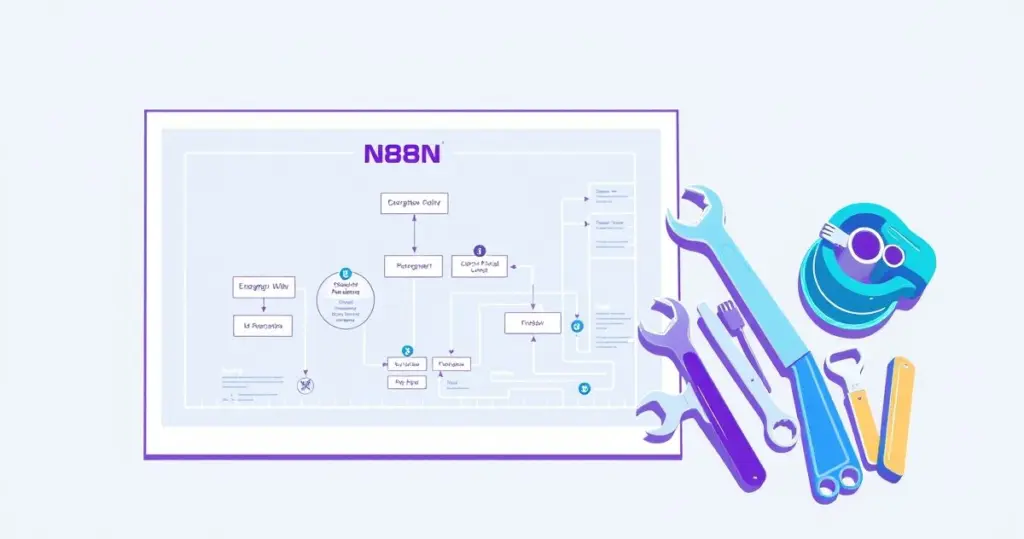Mastering n8n workflows is about more than just connecting a few nodes on a canvas; it’s a complete lifecycle that involves thoughtful design, strategic management, and continuous optimization. To build truly powerful and reliable automations, you need to think like an architect, planning for scalability and potential failures from the start. This means creating modular designs, establishing clear management practices like naming conventions and version control, and fine-tuning your workflows to be as efficient as possible with data and resources. By adopting this holistic approach, you can transform your n8n instance from a collection of simple tasks into a robust, well-oiled automation engine that drives significant business value.
The Art of Designing Robust n8n Workflows
Let’s be honest, we’ve all done it. You have a simple idea, you jump into n8n, and you start dragging and dropping nodes. An hour later, you have a 30-node monster that works… kind of. But is it readable? Is it maintainable? Will it break if someone looks at it funny? Probably not.
Building great n8n workflows is like building a house—you wouldn’t start hammering nails without a blueprint. The same principle applies here.
Plan Before You Build
Before you even open a new workflow, grab a whiteboard, a notebook, or just a piece of scrap paper. Ask yourself:
- What is the single, clear goal of this automation?
- What is the trigger? (A webhook, a schedule, a manual click?)
- What are the main logical steps? (Get data from A, transform it, check a condition, send it to B and C).
- What could go wrong? (API is down, data is missing, format is wrong).
Mapping this out first saves you countless headaches. It helps you see the bigger picture and avoid painting yourself into a corner.
Embrace Modularity with Sub-Workflows
One of the most powerful—and underused—features in n8n is the Execute Workflow node. Instead of building one gigantic workflow that does everything, you can break your logic into smaller, reusable components.
Imagine you have a process for enriching customer data that you use in three different automations. Instead of copying and pasting those nodes into each one, you build a single “Customer Enrichment” workflow. Then, your other n8n workflows can simply call this one using the Execute Workflow node. It’s cleaner, easier to update (you only change it in one place!), and dramatically improves readability.
Error Handling is Not an Afterthought
Nothing erodes trust in automation faster than silent failures. A workflow that stops working without telling anyone is a liability. This is where n8n’s error handling shines. You can configure what happens on error directly in a node’s settings or use a dedicated Error Trigger node to catch failures for an entire workflow.
A simple, professional pattern I always implement: if a critical step like “Update Salesforce” fails, the On-Error path triggers a node that sends a detailed failure message to a dedicated Slack channel. It takes 5 extra minutes to set up and builds incredible trust and reliability into your system.
Taming the Chaos: Managing Your n8n Workflows
As you build more automations, your n8n instance can quickly become a tangled mess of untitled and forgotten workflows. Active management isn’t just for neat freaks; it’s essential for collaboration, debugging, and scalability.
A Naming Convention That Actually Works
Inspired by some of the best practices I’ve seen in the n8n community (and massive GitHub repos of shared workflows), a solid naming convention is your first line of defense. A simple, effective format is:
[Trigger] - [Source] to [Destination] - [Purpose]
For example:
Scheduled - Shopify to Sheets - Daily Sales BackupWebhook - Stripe to Discord - Notify on New SubscriptionManual - Airtable to HubSpot - Sync Contact List
Instantly, anyone looking at your dashboard knows exactly what each workflow does without having to open it.
Don’t Sleep on Tagging and Version Control
Use n8n’s built-in tagging to categorize your workflows by department (Sales, Marketing, IT-Ops) or project. This makes filtering and finding things a breeze.
For those of you self-hosting n8n, you have an even greater superpower: Git. By storing your workflow JSON files in a Git repository, you get version history, collaboration features, and the ability to roll back to a previous version if an update goes wrong. The official n8n templates even include a workflow to automatically back up your workflows to GitHub!
From Good to Great: Optimizing Your n8n Workflows
An automation that works is good. An automation that works efficiently is great. Optimization is about making your n8n workflows run faster, use fewer resources, and be more resilient.
| Aspect | Inefficient Approach | Optimized Approach |
|---|---|---|
| Data Handling | Pass the full, massive API response between all nodes. | Use a Set node early to select only the fields you actually need. |
| Triggers | Poll an API every minute for changes (e.g., Cron node). |
Use a Webhook to receive real-time updates instantly when they happen. |
| Logic | Build a single, monolithic 50-node workflow. | Break logic into smaller sub-workflows called by an Execute Workflow node. |
| Error Handling | Let the workflow fail silently or stop completely. | Use On-Error settings to send notifications or run a fallback process. |
A Real-World Optimization Case Study
Let’s put this into practice. I once worked on a project where a client needed to sync inventory levels from their supplier’s API to their e-commerce store.
-
The Initial (Inefficient) Design: A
Cronnode ran every 5 minutes. It called an API to get a list of all 10,000 products and their stock levels. It then looped through every single item, compared it to the store’s database, and updated if necessary. This workflow was slow, resource-heavy, and hammered the supplier’s API. -
The Optimized Design: We had a conversation with the supplier. It turned out their system could send a
Webhookonly when a product’s stock level changed. We replaced the entire workflow with a new one starting with aWebhook Trigger. Now, instead of running constantly and checking 10,000 items, the workflow only runs when it needs to—maybe a few hundred times a day—and only processes a single item each time. The result? A massive reduction in server load, API calls, and execution time.
That’s the essence of optimization: it’s not just about tweaking nodes, but rethinking the entire process. Sometimes, the most powerful optimization is a simple conversation.
Ultimately, building exceptional n8n workflows is a craft that blends technical skill with strategic thinking. Start with a solid design, keep your house in order with smart management, and never stop looking for ways to make your automations work smarter, not harder.







